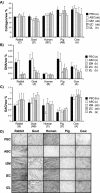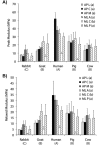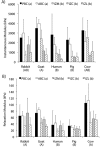An interspecies comparison of the temporomandibular joint disc
- PMID: 21118792
- PMCID: PMC3144103
- DOI: 10.1177/0022034510381501
An interspecies comparison of the temporomandibular joint disc
Abstract
The temporomandibular joint (TMJ) disc plays a critical role in normal function of the joint, and many disorders of the TMJ are a result of disc dysfunction. Previous quantitative TMJ characterization studies examined either the human or a specific animal model, but no single study has compared different species, in the belief that differences in joint morphology, function, and diet would be reflected in the material properties of the disc. In this study, we examined topographical biochemical (collagen, glycosaminoglycan, and DNA content) and biomechanical (tensile and compressive) properties of the human TMJ disc, and also discs from the cow, goat, pig, and rabbit. Regional and interspecies variations were identified in all parameters measured, and certain disc characteristics were observed across all species, such as a weak intermediate zone under mediolateral tension. While human discs possessed properties distinct from those of the other species, pig discs were most similar to the human, suggesting that the pig may be a suitable animal model for TMJ bioengineering efforts.
Figures




References
-
- Allen KD, Athanasiou KA. (2005). A surface-regional and freeze-thaw characterization of the porcine temporomandibular joint disc. Ann Biomed Eng 33:951-962 - PubMed
-
- Allen KD, Athanasiou KA. (2006a). Viscoelastic characterization of the porcine temporomandibular joint disc under unconfined compression. J Biomech 39:312-322 - PubMed
-
- Allen KD, Athanasiou KA. (2006b). Tissue engineering of the TMJ disc: a review. Tissue Eng 12:1183-1196 - PubMed
-
- Almarza AJ, Bean AC, Baggett LS, Athanasiou KA. (2006). Biochemical analysis of the porcine temporomandibular joint disc. Br J Oral Maxillofac Surg 44:124-128 - PubMed
-
- Beatty MW, Bruno MJ, Iwasaki LR, Nickel JC. (2001). Strain rate dependent orthotropic properties of pristine and impulsively loaded porcine temporomandibular joint disk. J Biomed Mater Res 57:25-34 - PubMed
Publication types
MeSH terms
Substances
Grants and funding
LinkOut - more resources
Full Text Sources
Other Literature Sources

